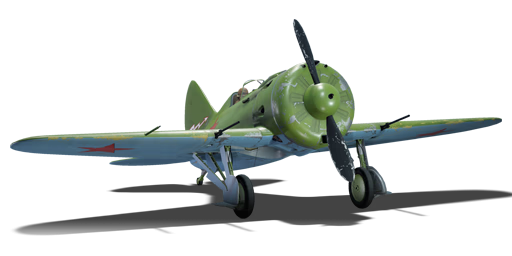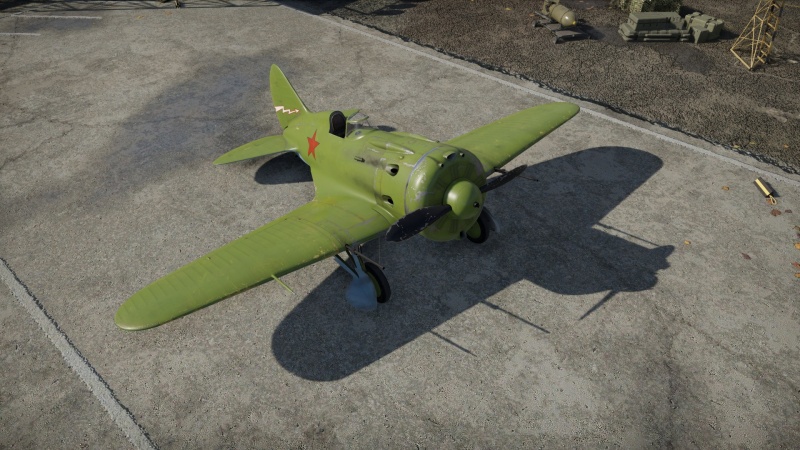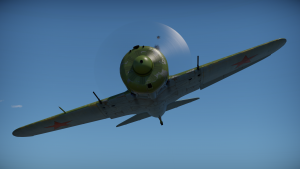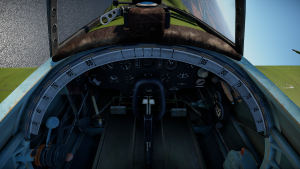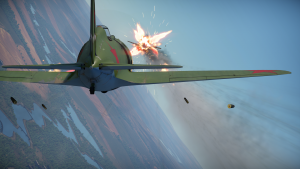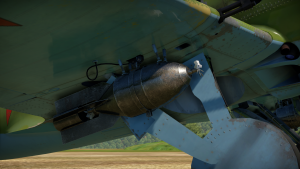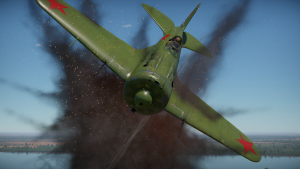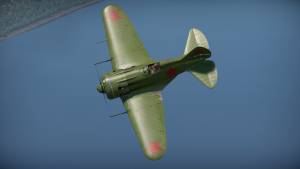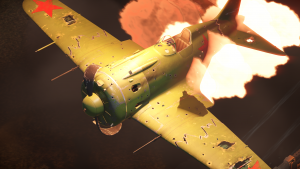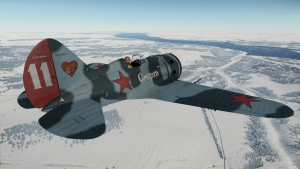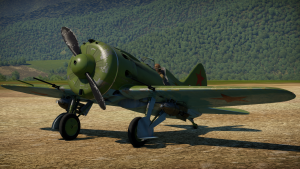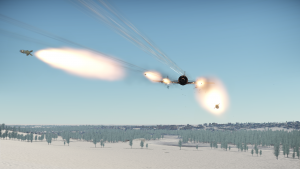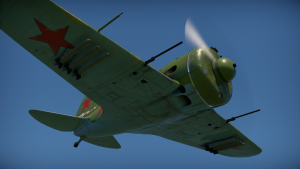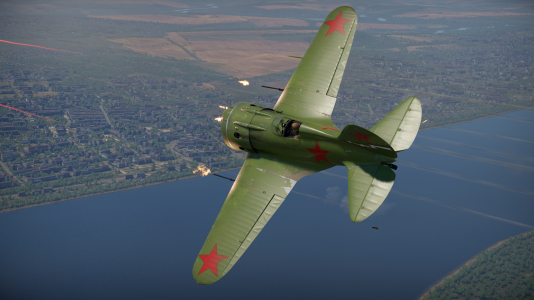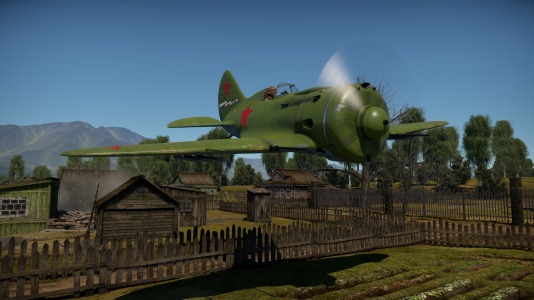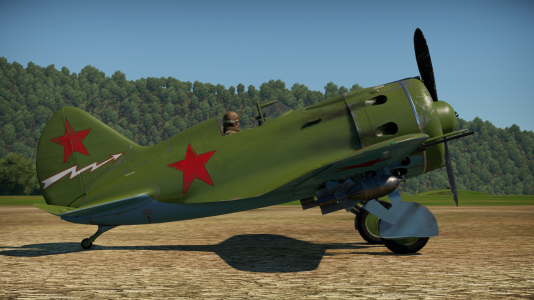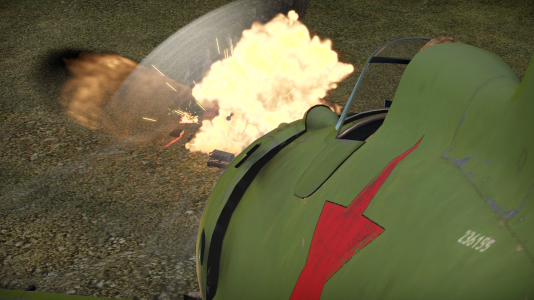Difference between revisions of "I-16 type 27"
Colok76286 (talk | contribs) (Edits) |
Colok76286 (talk | contribs) (Edits) |
||
| Line 21: | Line 21: | ||
The I-16 often falls behind other aircraft in the performance department. It has a poor top speed, coupled with a weak engine and poor high altitude performance, as well as poor energy retention. This makes the I-16 difficult to play when given the energy disadvantage. The I-16 however is the most manoeuvrable aircraft at its BR (save [[A6M (Family)|Zeros]]). The I-16 also has a great roll rate. One thing that is important to note is how the flaps behave. The I-16's flaps have only one setting, landing. Deployed flaps will rip above 200 km/h, and create excess drag. Don't try to use them in a dogfight, they won't be much help and they will most likely rip off. The gear also takes a long time to deploy, since it is hand-cranked. | The I-16 often falls behind other aircraft in the performance department. It has a poor top speed, coupled with a weak engine and poor high altitude performance, as well as poor energy retention. This makes the I-16 difficult to play when given the energy disadvantage. The I-16 however is the most manoeuvrable aircraft at its BR (save [[A6M (Family)|Zeros]]). The I-16 also has a great roll rate. One thing that is important to note is how the flaps behave. The I-16's flaps have only one setting, landing. Deployed flaps will rip above 200 km/h, and create excess drag. Don't try to use them in a dogfight, they won't be much help and they will most likely rip off. The gear also takes a long time to deploy, since it is hand-cranked. | ||
| − | The plane excels at low altitudes, like most Soviet aircraft. Dogfighting at high altitudes will result in you stalling out. Try to take on most fighters | + | The plane excels at low altitudes, like most Soviet aircraft. Dogfighting at high altitudes will result in you stalling out. Try to take on most fighters below 4,000 m. |
{| class="wikitable" style="text-align:center" width="70%" | {| class="wikitable" style="text-align:center" width="70%" | ||
| Line 238: | Line 238: | ||
;Skins | ;Skins | ||
| − | * [https://live.warthunder.com/feed/camouflages/? | + | * [https://live.warthunder.com/feed/camouflages/?vehicle=i-16_type27 Skins and camouflages for the {{PAGENAME}} from live.warthunder.com.] |
;Images | ;Images | ||
Revision as of 09:12, 13 June 2021
| This page is about the Soviet fighter I-16 type 27. For other versions, see I-16 (Family). |
Contents
Description
The I-16 type 27 Ishak is a rank II Soviet fighter with a battle rating of 3.3 (AB/RB) and 2.7 (SB). It was introduced in Update 1.39. It is the final development of the I-16, and it has the best set of weapons and ordnance available compared to the rest of the I-16s.
General info
Flight performance
The I-16 often falls behind other aircraft in the performance department. It has a poor top speed, coupled with a weak engine and poor high altitude performance, as well as poor energy retention. This makes the I-16 difficult to play when given the energy disadvantage. The I-16 however is the most manoeuvrable aircraft at its BR (save Zeros). The I-16 also has a great roll rate. One thing that is important to note is how the flaps behave. The I-16's flaps have only one setting, landing. Deployed flaps will rip above 200 km/h, and create excess drag. Don't try to use them in a dogfight, they won't be much help and they will most likely rip off. The gear also takes a long time to deploy, since it is hand-cranked.
The plane excels at low altitudes, like most Soviet aircraft. Dogfighting at high altitudes will result in you stalling out. Try to take on most fighters below 4,000 m.
| Characteristics | Max Speed (km/h at 2,000 m) |
Max altitude (metres) |
Turn time (seconds) |
Rate of climb (metres/second) |
Take-off run (metres) | |||
|---|---|---|---|---|---|---|---|---|
| AB | RB | AB | RB | AB | RB | |||
| Stock | 442 | 425 | 9950 | 17.3 | 17.9 | 13.8 | 13.8 | 272 |
| Upgraded | 490 | 463 | 16.1 | 16.5 | 23.6 | 18.0 | ||
Details
| Features | ||||
|---|---|---|---|---|
| Combat flaps | Take-off flaps | Landing flaps | Air brakes | Arrestor gear |
| X | X | ✓ | X | X |
| Limits | ||||||
|---|---|---|---|---|---|---|
| Wings (km/h) | Gear (km/h) | Flaps (km/h) | Max Static G | |||
| Combat | Take-off | Landing | + | - | ||
| 0 | 260 | N/A | N/A | 260 | ~16 | ~8 |
| Optimal velocities (km/h) | |||
|---|---|---|---|
| Ailerons | Rudder | Elevators | Radiator |
| < 300 | < 240 | < 280 | > 190 |
Survivability and armour
- 8.5 mm Steel plate on pilot's seat.
The armour will not save you. The I-16 has a weak and small airframe, so any shot is capable of severely crippling it. It is also worth noting that the I-16 has no canopy for the cockpit. The plane is not survivable in the least. However, you can make it so your plane never gets hit in the first place. Since your plane is small, pull evasive loops and turns to avoid enemy fire.
Modifications and economy
The upgraded ShVAK machine guns will be of utmost importance. These machine guns tend to jam up frequently, so prioritise them. As for the performance modifications, focus on the compressor, wings repair, engine, and engine injection. Research the bomb and rocket options last, or alternatively, if you use the plane in mixed battles, research the bombs first.
Armaments
Offensive armament
The I-16 type 27 is armed with:
- 2 x 20 mm ShVAK cannons, wing-mounted (150 rpg = 300 total)
- 2 x 7.62 mm ShKAS machine guns, nose-mounted (650 rpg = 1,300 total)
It is important to note that the ShKAS machine guns have a great rate of fire, the trade-off being that they jam quickly. Only use the guns in short bursts, to ensure they won't jam. The ShVAK cannons are the early models, meaning they have regular Tracer rounds. Select Air Targets belts for good results.
Suspended armament
The I-16 type 27 can be outfitted with the following ordnance:
- Without load
- 2 x 100 kg FAB-100sv bombs (200 kg total)
- 2 x 50 kg FAB-50sv bombs (100 kg total)
- 6 x RS-82 rockets
- 6 x RBS-82 rockets
The I-16 has good payload options for its BR and size. The bombs can kill pretty much anything if accurately dropped. The RBS-82 rockets are also capable of killing medium tanks if they are directly hit.
Usage in battles
Realistic:
In realistic battles this I-16 shares a similar playstyle as its predecessors, which is turnfighting. Start off the match by climbing between 10-17 degrees to gain altitude. Although this is not a real BnZ fighter, getting some altitude will still grant you many opportunities.
Your biggest threat when flying the I-16 comes from pretty much any fighter aircraft at this BR, since they all have a significant top speed/climb rate advantage (such as Ki-43 and Bf 109 F). A common scenario you will encounter is, you will see those planes higher than you before an engagement due to your inferior climb rate. They will always try to BnZ you, while your only effective tactic is to evade their dives and bleed their energy. Bank towards your teammates and keep climbing with WEP. As the enemy starts diving on you, wait until the distance closes to ~0.9 km, then use your great roll rate and turn rate, suddenly roll to one side and dodge under the attacker. This will usually force them to either shoot at an awkward position and miss (usually), or they will straight up relinquish the pass and pull up. Some enemies might lose patience after a few successful dodges and chase you rather than zooming away to try and destroy you. Now again utilise your agility to perform horizontal manoeuvres such as scissors, in a combination of short vertical movements such as Immelmanns and chandelles, to force an overshoot or to get on their tail. With careful aiming, the pair of ShVAK cannons will quickly destroy a fighter.
Remember to always avoid head-ons when playing this aircraft - it's super fragile, you can often get one shot by the heavy-armed aircraft at this BR, such as the Bf 109 E-4 and P-40 variants. Due to the lack of engine horse-power at high altitude, always try to engage enemy aircraft below 4,000 m, and DO NOT toggle flaps over 200 kph, because they will typically rip off at those speeds. Also, do not try to out-dive any monoplane as the I-16's light weight means that it is relatively slow at building up speed in a dive and also causes it to have lacklustre energy retention. However some short dives will gather you speed for more manoeuvres, or drag enemy BnZ planes to the deck. Once they are low, it is rather easy to outmanoeuvre them.
When confronting slower but more manoeuvrable planes such as Ki-27, energy tactics like BnZ are to be favoured over turning and burning. When you do not have altitude advantage over the Ki-27, the use of rolls is the most desired if not a nigh obligatory form of evasion. There is minimal chance to turn out or outrun the Ki-27, but you can out-roll it, particularly at high speeds. On the other hand, zoom climbs are a bit of a mixed bag. While the I-16 sometimes can get away with it through its superior power-to-weight ratio, the Ki-27 has a much lower stall speed which sometimes allows it to stay all the way through the zoom climb with I-16.
The I-16 is not a very effective interceptor, not being much faster than most monoplane bombers in its rank while having both a rather weak armament and protection.
Simulator:
The I-16 can be used in turnfighting, bomber intercepting and ground pounding. However in this mode, its characteristics appear to be quite conflicting. It is excellent in turning tightly and continuously, yet when manoeuvring it easily gets into uncontrollable spins which isn't beginner friendly. Also the rather big nose blocks the visibility a lot, offering very poor over-the-nose visibility which is a disadvantage in a turn fight, because when leading a shot the enemy will always get obstructed by the engine, making the player guess the shot. More ever, there is no trim control available in a sim battle and the I-16 always pitch up and down. Although not a lot, it is still annoying when trying to get a precise aim.
It is recommended to set the convergence within 300m, with vertical convergence on, because the majority of turnfights happen at that range or closer.
Unlike realistic, sim requires long-range flying so discard the habit of bringing the least fuel. Bring at least 30 minutes of fuel, although it decreases the plane's performance a bit, it prevents constant refueling which saves time for patrolling and fighting.
As your I-16 roars down the runway, you will notice that it shifts severely to the side, and the nose will tip down. If you don't correct it the propeller will eventually strike the ground, causing a failed takeoff. Thus you must put rudder input as opposed to the side it's shifting towards, and apply positive pitch to keep the propeller off the ground. You do not want to use flaps anywhere except takeoff and landing, since they are very weak and will rip at more than 260 km/h, while the average speed during a battle tends to be around 300 km/h. Once one or both flaps are gone it creates an imbalance in the roll axis, making spins more common. It also makes landing harder.
Before engaging a fight, it is better to have an altitude advantage first. When approaching the fight try to figure out which is your teammate and which is the enemy, to avoid going for a second pass, as the energy retention of the I-16 is rather slow. Also pick your target carefully. For easier aiming, you want to go for those unmanoeuvrable twin engine aircraft like Ju 88 or Ki-45, or bombers if there are any. Given the bad forward visibility of the I-16, these are the best options as they are quite slow and sluggish, and are a bigger target to hit. When dealing with fighters, it is way harder to aim. The elevator control of the I-16 is extremely sensitive, giving it good manoeuvrability, but at the same time, bad handling. The I-16 will respond in a very fast turn upon moving your stick / mouse by a little bit, which makes tracking nimble planes quite hard. But once you get used to it, try to lure every enemy into a turnfight, as that is where the I-16 shines. Several hits with the ShVAK cannon will effectively damage the enemy. If you find an enemy at your 6, utilise your great roll rate to do defensive manoeuvres like scissors to make them overshoot. Or you can simply do tight turns, most monoplanes won't be able to cut inside your turn and they might disengage. Important note: DO NOT put too much rolling and pitching input at once, as aforementioned the I-16 tend to enter spins easily.
If you are not very experienced in sim, you can also go for even bigger targets (bombers) for easier aiming. However you want to be more careful when hunting bombers, since with the Sim control (whether it be mouse joystick or a real stick) the plane will manoeuvre much more gently, making itself a great target for the bomber's gunners. DO NOT follow behind a bomber's 6 unless you are sure that its tail gunners are unconscious. Chasing behind a bomber makes yourself stationary for the tail gunners, and you will be showered with bullets. Your big radial engine will usually get damaged. Instead, before attacking, get an altitude advantage over the bomber by flying around 2 km above it. The bomber should only fill up about 1/6 of your gunsight. The best position for an attack is at the bomber's high 6 so you can adjust the lead much easier. Dive at the bomber, but not directly at it, try to predict where you two will crash by imagining yourself as a missile, that's where you should aim at (deflection shooting). To maximise the damage it is better to aim for their wings and engines, as the fuselage usually soaks up quite some bullets. Only fire when the bomber passes in front of your guns. This short window might seem inadequate to do anything, but with a accurate burst on the engine the twin ShVAK can deal quite a bit of damage. Without an engine most bombers cannot go far.
Although ground pounding ability is limited, there are still bombs and rockets to choose from. The 2 bombs can effectively destroy pillboxes or tanks while the rockets, with accurate aiming, can destroy 3 targets. Once the suspended armaments are gone, use the 2 MG for soft targets like trucks, artillery and AA cars. Save the ammo for the ShVAK in case of an unwanted dogfight.
Just like the SB 2M, the I-16 can still fly when it's extremely slow, causing it to bounce up during landing which can lead to a fatal crash. The trick is similar: slow it down more than other aircraft. Make sure you are around 1 km from the start of the runway and is no more than 300m high. When the runway fills up your gunsight, drop speed to around 210 kph and deploy landing flaps. The good thing is, the I-16 will not pitch up drastically upon using its flaps so you don't need to counter the extra lift. Make sure that you extend landing gears early as they move very slow (takes around 15 seconds to deploy). When you are about to touch down you should be flying at around 140 kph. You must control the rate of descent (I-16's gears are fragile) and make sure that you are slightly pitching upwards with the nose obstructing the horizon. This way the I-16 should land gently without having to brake for too long. Once you are sliding on the ground, fully deflect your elevators upwards to counter the momentum that can push the nose into the ground. You must release brakes once every 4 seconds, because if you only release them as the nose dips down, it's too late.
Enemies worth noting:
Ki-27, N1K1, He 51, Gladiator, etc;
Those commonly seen planes are equally good at turnfights and will be a hard target to down since they are very small and agile. To deal with them you need to practice leading and deflection shots, plus manoeuvres like barrel rolls and scissors. They are easily damaged by your ShVAK.
This bomber is not only quite durable, but also pretty fast. In level flight it can outrun the I-16 rather easily. Avoid being on its 6 as it will have at least 2x 7.92mm MG facing its tail, and their rapid rate of fire and good penetration is a big threat. Either go for a head-on or use deflection shooting and aim for its engines. If you cannot keep up with it, disengage. If it flies way higher than you, change your target.
This flying boat is like a low-tier Be-6. Its huge fuselage is very spacious and can absorb lots of bullets and shells. It also has lethal defensive firepower: two 7.7mm in the nose, four forward-facing, two on the top and four at the tail, so attacking from behind, in front or above aren't the best options. Dive under it and suddenly pull up to shoot its defenseless underpart. Aim at the large wings and engines, avoid shooting the fuselage.
These planes might not be able to out-turn the I-16, but they can easily outrun it as the I-16 is very slow. These fighters will usually BnZ you, so you must constantly look above and behind you. If they are diving on you, do what you do in realistic: use your roll rate and dodge under their negative G areas. Most players will try to follow up, if not immediately losing track of you. Several dodges might make them impatient and if they really start to turn with you, they are already dead.
Manual Engine Control
| MEC elements | ||||||
|---|---|---|---|---|---|---|
| Mixer | Pitch | Radiator | Supercharger | Turbocharger | ||
| Oil | Water | Type | ||||
| Controllable | Controllable Not auto controlled |
Not controllable Not auto controlled |
Controllable Not auto controlled |
Combined | Controllable 2 gears |
Not controllable |
Pros and cons
Pros:
- Excellent turning ability- with combat flaps deployed it can out-turn any Bf 109, Fw 190 A and even turnfighters like the Spitfire
- Extreme roll rate allows it to do offensive / defensive scissors easily, which is an advantage over Bf 109 and Spitfire as their roll rate aren't as good
- Twin ShVAK cannons have good rate of fire, adequate velocity and accuracy, and 150 RPG capacity allows for reasonably long engagements
- Suspended armament provides rockets and bombs which, to an extent, allows some ground attack ability
- Is a very short and small plane, offering the enemy a harder target to hit
- Has two ShKAS machine guns with great rate of fire to complement the cannons.
Cons:
- Extremely poor level speed, climb rate, dive acceleration and energy retention- will get outran, out-climbed and out-dived easily by Bf 109 E / F, Fw 190 A or A6M2
- Engine tends to overheat when diving at more than 500 km/h
- Control surfaces are unresponsive over 450 km/h
- Flaps are very weak and will break over 250 km/h, severely limiting its sharp-turning potential at higher speeds
- Hard to fly in SB -- very unstable in pitch, no manual trim controls, poor over-the-nose visibility and is prone to enter flat spins
- Uses early ShVAKs that have a lot of poor quality HEF-I rounds
- Although it's manoeuvrable, it can still be out-turned by some Japanese turnfighters
History
In-game description
A single-seat cantilever monoplane with a composite construction and retractable landing gear.
The I-16 Type 27 is a variation of the I-16 Type 18 fighter equipped with an M-62 engine and the same wing-mounted cannon armament as on the I-16 Type 17, which was created based on the I-16 Type 10 in the same way.
The I-16 Type 27 was powered by the 9-cylinder air-cooled Shvetsov M-62 radial engine with a rated output of 800 hp. The engine possessed a double-speed central-drive supercharger which increased its altitude limit. The plane was equipped with the AV-1 variable-pitch propeller with a larger propeller spinner.
One important alteration was the installation of a rubber self-sealing cover on the fuel tank. This prevented fuel leaks caused by small arms fire.
The I-16 Type 27's armament consisted of two 20 mm rapid-firing Shpitalny-Vladimirov ShVAK aviation cannons with 150 shells each. The cannons were located in the wing's central section outside the propeller interference zone. The fuselage housed a portion of the cannons' ammunition. The cannons were fed by tubes located behind the fuselage's first former and running across the central wing section along a forward longeron.
Two more synchronized ShKAS cannons were installed under nacelles in the fuselage above the engine. They had 650 rounds each.
The new cannons led to an increase in the airplane's weight and a corresponding reduction in its flight characteristics. For this reason, although the I-16 Type 27 was capable of aerial combat, it was mainly used to attack ground targets or as an interceptor.
The I-16 Type 27 was produced in small numbers in 1939. Only 59 were built in total. It saw limited use in the first stage of the Great Patriotic War, primarily as an attack aircraft.
Media
- Skins
- Images
See also
- Related development
External links
| Polikarpov Design Bureau (Опытное конструкторское бюро Поликарпова) | |
|---|---|
| I-15 | I-15 WR · I-15 M-22 · I-15 M-25 · I-15bis · Krasnolutsky's I-15bis |
| I-153 | I-153 M-62 · Zhukovsky's I-153-M62 · I-153P |
| I-16 | I-16 type 5 · I-16 type 10 · I-16 type 18 · I-16 type 24 · I-16 type 27 · I-16 type 28 |
| I-180 | I-180S · I-185 (M-71) · I-185 (M-82) |
| ITP | ITP (M-1) |
| Twin-engine fighters | TIS MA |
| Bombers | Po-2 · Po-2M |
| Export | ␗I-15bis · ␗I-153 M-62 · ␗I-16 type 5 · ␗I-16 type 10 · ␗I-16 type 17 · ␗I-16 Chung 28 |
| USSR fighters | |
|---|---|
| I-15 | I-15 WR · I-15 M-22 · I-15 M-25 · I-15bis · Krasnolutsky's I-15bis |
| I-153 M-62 · Zhukovsky's I-153-M62 · I-153P | |
| I-16 | I-16 type 5 · I-16 type 10 · I-16 type 18 · I-16 type 24 · I-16 type 27 · I-16 type 28 · I-180S |
| I-29 | I-29 |
| I-185 | I-185 (M-71) · I-185 (M-82) |
| I-225 | I-225 |
| ITP | ITP (M-1) |
| MiG-3 | MiG-3-15 · MiG-3-15 (BK) · MiG-3-34 |
| LaGG | I-301 · LaGG-3-4 · LaGG-3-8 · LaGG-3-11 · LaGG-3-23 · LaGG-3-34 · LaGG-3-35 · LaGG-3-66 |
| La | La-5 · La-5F · La-5FN · La-7 · Dolgushin's La-7 · La-7B-20 · La-9 · La-11 |
| Yak-1/7 | Yak-1 · Yak-1B · Yak-7B |
| Yak-3 | Yak-3 · Yak-3P · Yak-3T · Yak-3U · Yak-3 (VK-107) |
| Yak-9 | Yak-9 · Yak-9B · Golovachev's Yak-9M · Yak-9T · Yak-9K · Yak-9U · Yak-9UT · Yak-9P |
| Other countries | ▂P-40E-1 · ▂P-47D-27 · ▂Hurricane Mk IIB · ▂Fw 190 D-9 · ▂Spitfire Mk IXc |
| P-39 | ▂P-39K-1 · ▂Pokryshkin's P-39N-0 · ▂P-39Q-15 |
| P-63 | ▂P-63A-5 · ▂P-63A-10 · ▂P-63C-5 |


